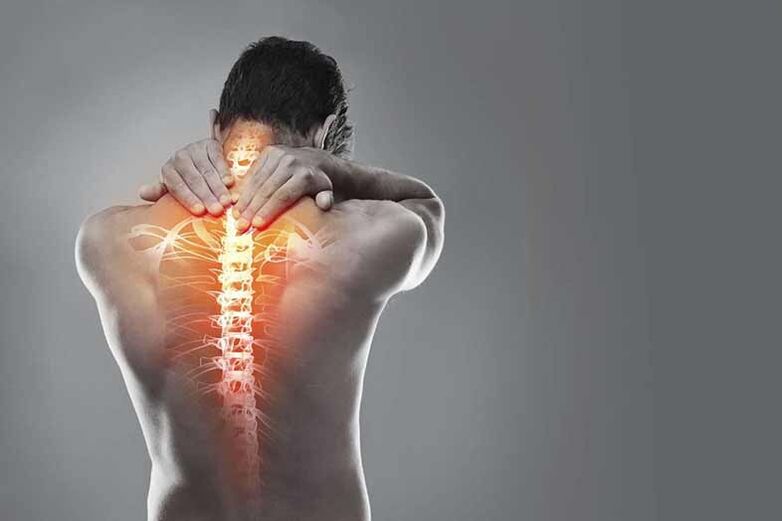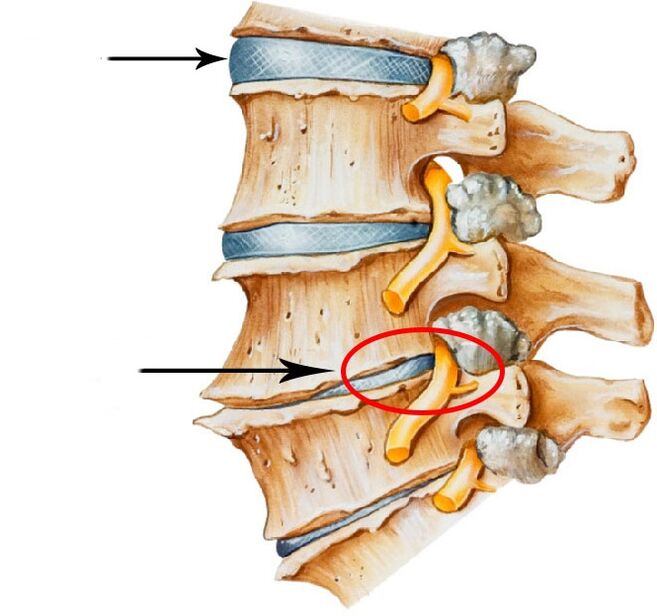
According to statistics, almost half of people who are 30 to 55 years old have osteochondrosis.Lower age thresholds in recent years have dropped to 18 years.
What is osteochandrosis
Spinal osteochondrosisIt is expressed in the defeat of the intervertebral disc, which loses elasticity, elasticity, cracks.
Cervical osteochondrosisIt is associated with damage to the disc on the cervical spine.
How the spine works
If to better understand the essence, then the spine device can be described as follows.
The spine consists of separate, similar to each other in the form of a vertebra located above the other.
Although there are some differences in shape, in the structure of all vertebrae is common.There is a hole in each vertebra - all holes are also one above the other and form a vertical channel (tunnel) through the entire spine.
In this spinal cord, the spinal cord passes.It goes vertically through a hole in each vertebra, and its roots (branches, where sensitive nerve endings) leave the canal between each vertebra pair.This is probably because the vertebra is not lost to each other and is not strictly tied, and between each vertebral pair there is a cartilage - an intervertebral disc.

Wheels together with ligaments connect the vertebrae to each other, and also play the role of shock absorber.Due to their elastic structure, they are elastic that are compressed during movement and tilt (from the side of the tendency) or unclenched (when straightforward).Therefore, the disc provides the spine with flexibility and soften the load from vertical pressure from top to bottom to each vertebral vertebra from the spinal column, as well as the vertical vibration that occurs while walking or walking.After all, one is a unique and straight creature.
Such spinal work is determined if the entire load is distributed correctly.Nature has created a very stable, durable and at the same time flexible.
And if not?
If the spinal cord, which is naturally contained, for some reason (bend, excess bend at the bottom, scoliosis, flat feet) or chronic chronic habits, lying down, standing, intervertebral compounds begin to wear, losing their elasticity, the ability to perform hatred, they step to the side, forming hernia.
Wear an intervertebral disc - there is also a person's calculation to upright.After all, only in the spine human has a vertical burden.Vertical shifts throughout the life of all spinal components (especially in people with overweight) lead to a gradual deterioration in blood supply to the intervertebral disc (vascular direction) - the disc loses resistance and strength.
What's coming?

The hernia disk pressedArtery,Nerve rootAnd sometimes -sometimesspinal cord.
As a result of cervical osteochondrosis
Due to changes in the anatomical ratio of the spine, the blood vessels (main arteries and veins) are squeezed.
What happened:Due to changes in the anatomical ratio of the spine, the blood vessels (main arteries and veins) are squeezed.What leads to:
- To violate blood flow into the brain and a violation of full nutrition.
- To violate the flow of veins and the accumulation of toxic substances in the brain tissue.
How it shows yourself:
- Dizziness (up to short consciousness).
- Headache.
- Visual deterioration.Smell violations, taste.
- Bulbar disorders related to difficulty swallowing, pronunciation, general respiratory violations and speech.
- Cognitive disorders: impaired memory, perception, complexity with attention concentration, complexity with logical thinking.Reading violations.
- Absent -mindedness.Inappropriate.Decreased confusion.Forget.
- Difficulty by expressing complex and long words, complex grammar construction.
- Reduces performance, hard work.
- Violations in emotional and personal areas: sharp and unreasonable mood changes, emotional incontinence, irritation, anger.
Diagnosis: Cognitive disorders, aphasia, Bulbar dysarthria, encephalopathy disrunities, vertebro-based deficiency (VBN), etc. can be diagnosed. Drug therapy taken in this case:
- Vascular medicine.They have a very low evidence basis.They need the use of doctors and under the control of the doctor, they can cause a large number of complications and different side effects.
- Nootropic medicine.Requires strict use for appointment and under the control of a doctor.Many have relatively serious contraindications to the cardiovascular system (with hidden heart pathology, serious negative consequences can cause).Most nootropes do not have positive pharmacological results, that is, it is useless.
- Drugs with sedative effects, including sedatives, antidepressants, barbiturates, bromide.Psychotropic medicine.Requires strict use for appointment and under the control of a doctor.They can be addictive and have many side effects (dizziness, headache, visual deterioration and urine, dry mouth, nausea, and other disorders, decreased libido, sleep disorders, a set of weight).
There is a squeeze (compression) of the nerves - the nerves that come from the spinal cord to the upper organs and tissues of the body.
What happened:
There is a squeeze (compression) of the nerves - the nerves that come from the spinal cord to the upper organs and tissues of the body.
What leads to: To clear pain syndrome, often chronic, recurrent.
How it shows yourself:
- Pain in the neck, back of the head (with head or rest, shot or chronic).
- Headache (headache tension associated with the tension of the posterior surface of the neck and head - pain, poured over the entire head, often accompanied by sound and ringing in the ear, flies in front of the eyes).
- Pain in the upper chest.
- Pain that simulates pain in the liver, in the lungs.
- Pain in the upper part of the shoulder, shoulder.
- Pain in the shoulder joint or throughout the hand.
- Fingerprints, hands, hands completely.
Drug therapy taken in this case:
- Nonsteroid anti-inflammatory drugs (painkillers, antipyretic), which require strict use for appointment and under the control of doctors and have a negative reaction of the gastrointestinal tract (gastritis, ulcer, ulcerative bleeding), cardiovascular system, kidneys.
- Preparation of muscle hypertonicity, which requires strict use for the intended purpose and under the control of the doctor and has a negative reaction in the form of a strong dizziness, weakness to completely exhausting.
The use of drug therapy is the most common practice in the treatment of osteochondrosis.However, this is a symptom treatment.Medicines are used to stop the process of inflammation and pain (sometimes you need to use novocaine blockade), decreased neurological and psycho symptoms.The most important thing is that pharmacological therapy occurs under the strict supervision of a doctor.
However, if you do not directly stop the process of violations of the vessels, do not restore the balance of the spine and all related structures laid down by nature (violation of the symmetry of the body, flat feet, muscle cramps that occur as a compensatory reaction to equilibrium), the disability will notAnywhere and at some point it does not help and should not help and should resort to the operation.
Osteopathic treatment is intended to eliminate the causes of osteochondrosis above, which is today recognized as the most effective.
Osteopathic treatment of osteochandrosis
Rule No.1 "earlier, better" in the case of osteochondrosis, it works mainly!After all, to cure osteochondrosis - it does not erase pain or other syndrome, but to restore the normal position of the spine, to provide an intervertebral disc with a full nutrition (to restore normal blood supply) even before the degenerative process in the cartilagin tissue will be irreversible.
Osteopath determines a place where displacement or deformation has occurred, foundThe reason why the ships in the spine happened.Osteopathy considers the body as a single system where everything is interrelated and influenced one another, literally attracting one by one.This means that osteopath returns the work of all structures, a change in which the chain leads to the violation of the power of the intervertebral disc.The task of osteopath is to restore the ratio of organ and tissue balance, eliminating stress and clamps that interfere with full nutrition.And if, in the case of a neglected disease, changes in the spinal structure involve violations of internal organ function, osteopathic treatment will be intended to eliminate dysfunction.
That is, osteopath works with the main cause of the disease, not with the removal of its syndrome, including pain.Although he will start his work with this, by relieving pain.However, it won't stop there.The best way of osteopathy works in combination with physiotherapy (ensuring pain decreases and inflammation) and physiotherapy training - exercise therapy (strengthening muscle corset, helps the body stay in an unusual, but correct position).
Conclusion
- The neck cannot be treated unlucky.Because the brain should be prepared with unobstructed nutrition.And it depends on how much his neck is a healthy "conductor".
- You can't wait.The more illnesses are launched, the more difficult to roll (and sometimes it is impossible).Osteopath can determine the disease when it is still in rudiment and is not real in any way.You cannot ignore diagnostic checks.
- It is not possible to ignore the prevention of osteochondrosis.It is always easier than treating the disease.

























